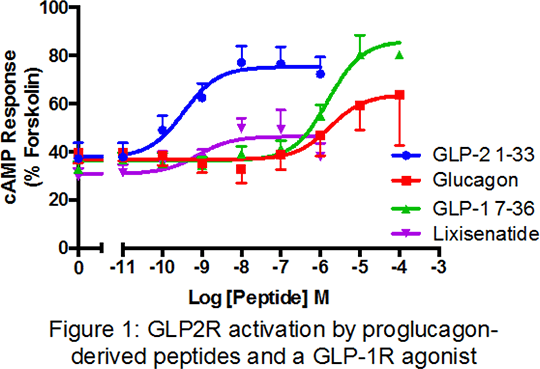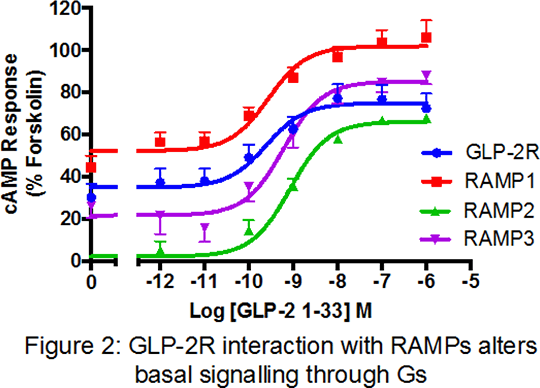Activation and modulation of the GLP-2R by incretin hormones and RAMPs Glucagon-like peptide 2 (GLP-2) is a 33 amino acid peptide derived from proglucagon and secreted from intestinal enteroendocrine L cells (1). Activation of the GLP-2 receptor (GLP-2R) causes crypt cell proliferation in the small intestine, and has been found to improve nutrient absorption in patients with short bowel syndrome (1, 2). The GLP-2R signals through Gas leading to cAMP production. It has a 40% similarity to other proglucagon-derived peptides, GLP-1 and glucagon, which activate family B G-protein coupled receptors (GPCRs) to regulate blood glucose (1) and are currently targets for diabetes treatment. We therefore investigated the ability of these peptides and a therapeutic GLP-1 mimetic, lixisenatide, to activate the GLP-2R and stimulate cAMP production. The receptor was transiently transfected into HEK293 cells and cAMP production measured using a PerkinElmer LANCE assay kit (3). Each peptide bound and activated the receptor (Fig.1), with GLP-1 7-36 acting as a low potency full agonist (pEC50 = 5.81 ± 0.21, Emax = 86.15 ± 6.24), and glucagon (pEC50 = 5.76 ± 0.57, Emax = 63.69 ± 7.84) and lixisenatide (pEC50 = 9.1 ± 0.62, Emax = 46.37 ± 3.33) acting as partial agonists compared to full agonist GLP2 1-33 (pEC50 = 9.46 ± 0.37, Emax = 75.27 ± 3.86) (n = 9). Receptor activity modifying proteins (RAMPs) are known to interact with some family B GPCRs where they modulate signal transduction and influence ligand specificity (3). However, a pharmacological analysis of these interactions for the GLP-2R has not been carried out. We investigated cAMP production of the GLP-2R by GLP2 1-33 in the presence of each of the RAMPs (Fig. 2). RAMP1 significantly increased basal signalling through Gas (P < 0.01, one-way ANOVA and Dunnett’s test), while RAMP2 significantly reduced basal signalling (P < 0.001) (n = 18). While there were no significant changes to pEC50, RAMPs 2 and 3 significantly increased GLP-2R signalling range (P < 0.005 and P < 0.01, respectively). This data demonstrates that GLP-1, glucagon and lixisenatide can act at the GLP-2R, and signalling via this receptor is enhanced by RAMPs. This information should lead to the rational design of more targeted drugs with fewer side effects.
References 1) Walsh, N et al (2003) Endocrinology 144: 4385 – 4392, (2) Guan, X et al (2006) Gastroenterology 130 : 1019 – 1021, (3) Weston C et al (2015). J Biol Chem 290: 23009 – 23022 This research was funded by BBSRC grants BB/M00015X/1 and BB/M000176/1.
|



